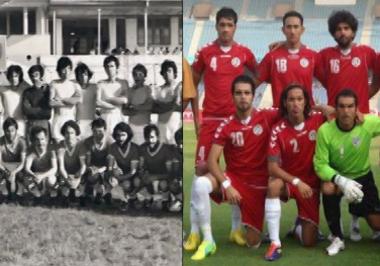Several Afghan football veterans and experts took the opportunity to applaud and reflect on the progress of competitive football in Afghanistan following the historic Afghan championship win over India in the South Asian Football Federation (SAFF) Cup on Wednesday night.
According to Abdul Hamid Mubarez, a retired national team player and respected authority on Afghan football history, football was largely introduced to Afghanistan in 1924-1925, during the rule of Amir Habibullah. Afghan boys were trained in the sport by foreign trainers at the school level. A number of football teams such as the Habibia High School Football Team, Esteqlal High School Team, Tafreeh Team and Mahajer Team were formed.
For years, Afghanistan did not have a national team to compete internationally and only regional football teams were playing against each other at the national level. In 1948, however Afghanistan joined FIFA and the team played several matches in Berlin, London and India. The early teams were not very competitive and failed to make any notable achievement on the international stage, reportedly due to a lack of proper training and coaching.
"Back then we went to India 40 days early to start preparing for the game against the national team," Mubarez said. "We played against clubs in India and we won, but on the day of the match, India got lucky and defeated us 1-0. Our team played well though."
Football in Afghanistan was largely brought to a halt during the war against the Soviets during the 1980s and then the civil war period of the early 90s. Although football matches occurred under Taliban rule, they were frowned upon by the hardliner Islamists regime and often entailed public executions of lawbreakers at halftime. No international matches were played by Afghanistan between 1984 and 2002.
Since the fall of the Taliban in 2001, football in Afghanistan has seen a renaissance, receiving increased attention and funding like never before. The 2003 SAFF Cup was where Afghanistan made its return to the international stage. The SAFF finals win on Wednesday night, however, marked a new height in Afghan football's development.
"We had been working on a plan for a few years now, and I am glad that the plans were implemented successfully and resulted in winning the SAFF Championship," said Ali Askar, a representative of FIFA in Afghanistan.
No national association professional league had ever been officially formed in Afghanistan until 2012, when the Afghanistan Football Federation (AFF), Roshan Telecom and MOBY Media Group collaborated to inaugurate the Roshan Afghan Premier League (RAPL). The AFF selected three coaches to pick the best players and form eight teams representing eight zones, spanning the entire country.
The efforts put in by the AFF, Roshan and MOBY have witnessed Afghanistan's first ever full-fledged football league, televised for the whole country to watch. The league is now in its second season and has grown in popularity.
The professional league is considered a major benefit for the national team as well, providing players greater training opportunities and gametime experience to raise their skill-levels.
"New plans are in place and we have started working over the past decade. We will move forward and make significant achievements. But, for all this we need support from the government, businessmen, media and citizens," said Abdul Saboor Walizada, the head of the AFF.
While experts and veterans of football in Afghanistan feel that incredible progress has been made, evidenced in the national team's success and the emergence of the RAPL, many still acknowledge there is still room for improvement. With the SAFF Cup now in the bag, it is likely Afghans will set their eyes higher with there still being many taller mountains to climb on the international football scene. Most would undoubtedly like to see the Afghan colors represented in the World Cup someday.



Comment this post